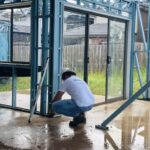Child Safety and Swimming Pools
Child Swimming Pool Risks
Swimming pools are prevalent in numerous Australian backyard and holiday park settings; however, they can pose significant risks to children if proper precautions are not taken. The Australian Institute of Health and Welfare reported that there were 66 drowning deaths in swimming pools throughout Australia, with a majority involving young children between the ages of 1 and 4. Additionally, falls from diving boards accounted for an additional 20 fatalities, while electrocution was a contributing factor in another 18 deaths. Many accidents occur due to a lack of awareness about these risks and failure to implement preventive measures.
Early prevention and education
It is crucial to educate children early on water safety, ensuring they comprehend the potential dangers of being near water. Teaching them to swim at a young age can help them have fun and safely participate in activities like going to the beach or swimming pool with friends. Additionally, parents must remain vigilant when their children are swimming by consistently supervising them and making certain that they wear lifejackets for added protection.

Pool safety concerns amidst rising cost of swimming lessons for children. To address the issue of rising cost of swimming lessons for children, it is important for communities and government authorities to prioritize the importance of water safety education.
Parental Responsibility
While many people believe swimming pools to be a safe setting for children, the reality is that they can pose significant risks if not properly supervised. Parents must educate themselves on protecting their children from these dangers and ensure constant supervision when near or in water. Swimming pool hazards include drowning, electrical hazards, diving board falls, and underwater entrapment. To prevent such incidents, it is important to teach children about pool safety early on and train adults in effective supervision techniques. Offering swimming lessons at a young age will also equip non-swimmer children with essential skills for future water safety.
To prevent injuries, it is important for swimming pool owners to consider risk factors such as parental supervision and water depth. Pool safety can be improved by diligently monitoring the pool’s condition and educating children on safe swimming practices. It is ideal for all pools to meet health and safety standards to minimize the potential for accidents. However, when pools are not designed according to these requirements, there is an increased risk of incidents.
Child Safety Requirements
To prevent accidents and injuries in swimming pools, it is crucial for pool owners to maintain their pools and adhere to safety regulations properly. When using a swimming pool, the public should ensure their children are always supervised in the water and wearing an appropriate life jacket. It is highly important for parents to prioritize the safety of their children around water by taking necessary precautions to avoid any injuries or drowning incidents while swimming. By ensuring early swim lessons, following safety guidelines during supervision, and providing proper life jackets, parents can fulfil their responsibility towards keeping their children safe while they swim.
Child CPR Training and Safety
It is important for pool owners to prioritize the safety of all family members by ensuring they are adequately trained in providing supervision and maintaining a safe environment. It is also crucial for them to be aware of potential hazards associated with different types of swimming pools and make any necessary modifications to minimize the risk of injuries. By doing so, families can enjoy their summer swimming season without worrying about accidents or drownings.
For larger pool owners or those who manage public swimming facilities, staff members must receive proper training on emergency protocols. Lifeguards should be equipped with CPR skills and other life-saving techniques to respond to emergencies and prevent unnecessary harm effectively.

Ongoing water safety education and awareness programs should be implemented to ensure that both children and adults have the knowledge and skills necessary to prevent drowning incidents.







